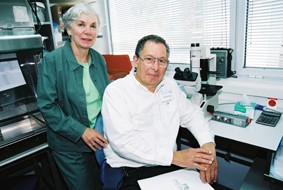
In 1967, David Haas, a young postdoctoral researcher at the Institute, wrote a paper on a new process he'd developed for freezing biological crystals. Time passed; he changed careers and forgot about it. More than 30 years later, over a friendly lunch with a professor, Haas was reminded about his crystallization work and learned that his achievement at the Institute had revolutionized research. Says Haas: “That conversation was a real journey 'back to the future.’”
Haas and his wife, Sandy, arrived at Haifa Port in December 1966, and they still vividly recall the contrasts: “We'd come from the formal atmosphere of Great Britain’s Royal Institute, where the Friday evening lecture series was a black-tie affair,” says Sandy. “In Israel, T-shirts and sandals were almost never out of place, and our apartment at Lunenfeld-Kunin overlooked a lovely orange grove.” The Haases agree that it was the casual, informal nature of the Weizmann Institute as well as the availability and sharing of state-of-the-art equipment that contributed so significantly to the freedom to experiment and be creative in the lab.
Haas began his postdoctoral research in crystallography – the study of crystal structures by X-ray diffraction – under Prof. Wolfie Traub of the Institute's Chemistry Department. He developed a method of freezing, called cryocrystallography, which stabilizes protein crystals otherwise subject to damage or destruction during the complex processes required to analyze them. This method is now standard for biological and protein crystal analyses. In 1967, only two or three protein structures were known; the data collection process required a large number of crystals and took about six to twelve months. As a result of Haas's research, the same analysis can today be completed in two to three hours, and some 20,000 protein structures are now known.
The development of cryocrystallography was completed within just six months, in the time leading up to, during and shortly after the Six-Day War. Most scientists and staff were called to military service or evacuated, and Haas remained behind with only a handful of researchers. His most vivid memories are unrelated to science: “As a volunteer in the Institute's fire brigade, I camped out on the steps of the Stone Administration Building and saw the artillery flashes over Jerusalem. I listened to the mid-war radio broadcast of former Weizmann Institute president and Israeli Foreign Minister Abba Eban's address to the U.N.”
Haas’s research was cut short by the instability of life after the Six-Day War, and he left Israel to continue briefly at Purdue University. Soon after, he chose a career in security systems, and he and his wife successfully founded several companies. Today, with some 50 patents to their credit, Haas is president of TECCO Corporation operating out of Suffern, New York. Among his inventions is a self-expiring identification badge made of “paper that tells time.”
The Haases never lost their ties with Israel: All three of their sons participated in youth programs in Israel, and Stuart, the oldest, made aliyah in 1989. “So many things have changed since our first trip in 1967,” remarks Sandy, “but I was struck even then by how far Israel had come in such a short time.” Recently, the Haases have taken their involvement in the country one step further and reestablished their connection with the Institute in the process: Since 2002, they have served as Diplomats of the American Committee for the Weizmann Institute of Science.
